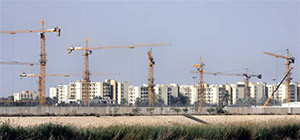by Daniel Pipes
National Review Online
March 30, 2010
Iraq’s recently-concluded, inconclusive elections will be followed in August by the pullout of American troops, making this a good time to ask what American taxpayers have achieved with the US$45 billion spent on reconstructing Iraq since 2003 and what steps to take next.

U.S. Embassy Baghdad under construction. |
That $45 billion includes no expenditures on the U.S. military itself but $21 billion for Iraqi security forces, $11 billion for Iraqi infrastructure, and $6 billion for various Iraqi government-related services.
Sadly, this vast sum has largely been wasted. Firstly, because once coalition forces leave Iraq in August, the mullahs in Tehran will begin their takeover; second, because hubris and incompetence have riddled U.S. spending in Iraq. To get some sense of those errors, let’s review the highest priority American project, namely the U.S. embassy complex in Baghdad.
Everything about this embassy, planned at the height of the U.S. occupation in 2004, is gargantuan. As the largest diplomatic facility on Earth, it extends 104 acres (42 hectares), making it ten times larger than the next largest embassy complex (the U.S. mission in Beijing) and only slightly smaller than Vatican City. A mini-city unto itself, its 21 buildings include stores, restaurants, schools, a movie theater, fire station, and facilities for athletics, electricity, telecommunications, water, and wastewater. Fifteen-foot thick walls protect the complex. Some 5,500 staff live there. The annual embassy budget comes to about $1.5 billion.
The complex has suffered from cost overruns, delays, and shoddy construction. Projected to cost $592 million and open in 2007, it actually cost $700 million and opened in 2009. A Washington Post article recounts the travails of a brand-new guard house:
The first signs of trouble … emerged when the kitchen staff tried to cook the inaugural meal in the new guard base on May 15[, 2007]. Some appliances did not work. Workers began to get electric shocks. Then a burning smell enveloped the kitchen as the wiring began to melt. … the electrical meltdown was just the first problem in a series of construction mistakes that soon left the base uninhabitable, including wiring problems, fuel leaks and noxious fumes in the sleeping trailers.
The trailer manufacturer, a Saudi company, helpfully suggested that guards keep the windows open and use charcoal to absorb the odor, but to no avail. All ten power stations developed leaks because builders used Teflon tape designed for water, which fuel dissolved on contact.
Poor construction can be remedied, but not the compound’s taunting size and aggressive location, which imply permanent American rule over Iraq. The embassy sits on appropriated (i.e., not purchased) land in the “Green Zone,” a governmental area once belonging to Saddam Hussein that borders the Tigris River in the heart of Baghdad.
The International Crisis Group notes that the massive embassy complex “is seen by Iraqis as an indication of who actually exercises power in their country.” Jane C. Loeffler, author of The Architecture of Diplomacy: Building America’s Embassies, adds that Washington “has designed an embassy that conveys no confidence in Iraqis and little hope for their future.” Anne Gearan of the Associated Press rightly predicts that the complex “quickly could become a white elephant.” William Langewiesche derides the complex as a self-built “prison.”
Not surprisingly, America’s kept politicians in Iraq welcome this assertion of American muscle: Iraqi President Jalal Talabani says the complex serves “a symbol of the deep friendship between the two peoples of Iraq and America,” while Foreign Minister Hoshyar Zebari endorses its colossal dimensions, seeing in it “a sign of the American government’s commitment to democracy in Iraq.”
Six years ago, I declared myself uneasy due to “the monumental size of this embassy, … Far better would be to turn decisionmaking over to a strong Iraqi leader and maintain a small U.S. presence. If not done earlier, I fear, this will be done later, and under less auspicious circumstances.” Those inauspicious circumstances are now five months away; the oversized complex on appropriated land in central Baghdad will likely become a symbol of U.S. arrogance, irritating Iraqis and making the country more vulnerable to Iranian influence.
The damn thing’s been built, so it’s too late to stop that act of diplomatic over-reach. But the sooner the complex is turned over to Iraqis, with Americans moved to a normal-sized embassy on duly purchased land, the better for future U.S.-Iraq relations.
Mr. Pipes is director of the Middle East Forum and Taube distinguished visiting fellow at the Hoover Institution of Stanford University.









